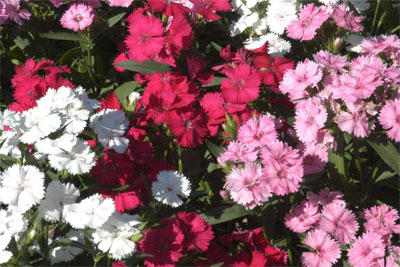Garden Pinks

The similarities are obvious: garden pinks are closely related to florists’ carnations. Same blue-green foliage. Same clove-like aroma. Same petals that look like they were trimmed with pinking shears (hence the plant’s common name).
There, however, the similarities end. Garden pinks are intended to be grown outdoors, in our flowerbeds. And, since they are tolerant of winter’s cold in most parts of Texas, we use them outdoors in beds and color bowls.
Pinks’ flowers are single or semi-double. They’re available in mixes as well as in individual colors of reds, pinks, whites and lavenders, many with attractive bi-colored banding. Flowers are borne on 8- to 15-inch stems, and each stem will produce many buds and blooms.
Give pinks full, or nearly full sun. Plant them 10 to 14 inches apart in beds that have been amended with several inches of organic matter such as peat, compost, finely ground pine bark mulch and rotted manure. If you’re amending a tight clay soil, incorporate 1 inch of expanded shale with the organic matter. Fertilize pinks with a complete-and-balanced, water-soluble plant food each time that you water them. You can also use an encapsulated high-nitrogen lawn fertilizer on the beds in February and through the spring.
Even though some nursery labels categorize pinks as perennials, they are best treated as annuals in Texas. As the plants begin to struggle with late-spring heat, replace them with your warm-weather color.
